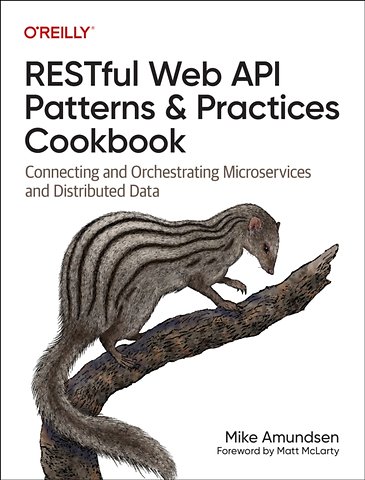

An internationally known author and lecturer, Mike Amundsen travels throughout the United States and Europe consulting and speaking on a wide range of topics including distributed network architecture, Web application development, Cloud computing, and other subjects.
Meer over Mike AmundsenRESTful Patterns and Best Practices for API′s Cookbook
Connecting and Orchestrating Microservices and Distributed Data
Paperback Engels 2022 1e druk 9781098106744Samenvatting
Many organizations today orchestrate and maintain apps that rely on other people's services. Software designers, developers, and architects in those companies often work to coordinate and maintain apps based on existing microservices, including third-party services that run outside their ecosystem. This cookbook provides proven recipes to help you get those many disparate parts to work together in your network.
Author Mike Amundsen provides step-by-step solutions for finding, connecting, and maintaining applications designed and built by people outside the organization. Whether you're working on human-centric mobile apps or creating high-powered machine-to-machine solutions, this guide shows you the rules, routines, commands, and protocols—the glue—that integrates individual microservices so they can function together in a safe, scalable, and reliable way.
- Design and build individual microservices that can successfully interact on the open web
- Increase interoperability by designing services that share a common understanding
- Build client applications that can adapt to evolving services without breaking
- Create resilient and reliable microservices that support peer-to-peer interactions on the web
- Use web-based service registries to support runtime "find-and-bind" operations that manage external dependencies in real time
- Implement stable workflows to accomplish complex, multiservice tasks consistently
Specificaties
Lezersrecensies
Inhoudsopgave
Preface
About This Book
Conventions Used in This Book
Using Code Examples
How to Contact Us
Acknowledgments
Understanding RESTful Hypermedia
1. Introducing RESTful Web APIs
What Are RESTful Web APIs?
Why Hypermedia?
Shared Principles for Scalable Services on the Web
2. Thinking and Designing in Hypermedia
Establishing a Foundation with Hypermedia Designs
Increasing Resilience with Hypermedia Clients
Promoting Stability and Modifiability with Hypermedia Services
Supporting Distributed Data
Empowering Extensibility with Hypermedia Workflow
Hypermedia Recipe Catalog
3. Hypermedia Design
3.1. Creating Interoperability with Registered Media Types
3.2. Ensuring Future Compatibility with Structured Media Types
3.3. Sharing Domain Specifics via Published Vocabularies
3.4. Describing Problem Spaces with Semantic Profiles
3.5. Expressing Actions at Runtime with Embedded Hypermedia
3.6. Designing Consistent Data Writes with Idempotent Actions
3.7. Enabling Interoperability with Inter-Service State Transfers
3.8. Designing for Repeatable Actions
3.9. Designing for Reversible Actions
3.10. Designing for Extensible Messages
3.11. Designing for Modifiable Interfaces
4. Hypermedia Clients
4.1. Limiting the Use of Hardcoded URLs
4.2. Coding Clients to Be HTTP Aware
4.3. Coding Resilient Clients with Message-Centric Implementations
4.4. Coding Effective Clients to Understand Vocabulary Profiles
4.5. Negotiating for Profile Support at Runtime
4.6. Managing Representation Formats at Runtime
4.7. Using Schema Documents as a Source of Message Metadata
4.8. Every Important Element Within a Response Needs an Identifier
4.9. Relying on Hypermedia Controls in the Response
4.10. Supporting Links and Forms for Nonhypermedia Services
4.11. Validating Data Properties at Runtime
4.12. Using Document Schemas to Validate Outgoing Messages
4.13. Using Document Queries to Validate Incoming Messages
4.14. Validating Incoming Data
4.15. Maintaining Your Own State
4.16. Having a Goal in Mind
5. Hypermedia Services
5.1. Publishing at Least One Stable URL
5.2. Preventing Internal Model Leaks
5.3. Converting Internal Models to External Messages
5.4. Expressing Internal Functions as External Actions
5.5. Advertising Support for Client Response Preferences
5.6. Supporting HTTP Content Negotiation
5.7. Publishing Complete Vocabularies for Machine Clients
5.8. Supporting Shared Vocabularies in Standard Formats
5.9. Publishing Service Definition Documents
5.10. Publishing API Metadata
5.11. Supporting Service Health Monitoring
5.12. Standardizing Error Reporting
5.13. Improving Service Discoverability with a Runtime Service Registry
5.14. Increasing Throughput with Client-Supplied Identifiers
5.15. Improving Reliability with Idempotent Create
5.16. Providing Runtime Fallbacks for Dependent Services
5.17. Using Semantic Proxies to Access Noncompliant Services
6. Distributed Data
6.1. Hiding Your Data Storage Internals
6.2. Making All Changes Idempotent
6.3. Hiding Data Relationships for External Actions
6.4. Leveraging HTTP URLs to Support âContainsâ and âANDâ Queries
6.5. Returning Metadata for Query Responses
6.6. Returning HTTP 200 Versus HTTP 400 for Data-Centric Queries
6.7. Using Media Types for Data Queries
6.8. Ignoring Unknown Data Fields
6.9. Improving Performance with Caching Directives
6.10. Modifying Data Models in Production
6.11. Extending Remote Data Stores
6.12. Limiting Large-Scale Responses
6.13. Using Pass-Through Proxies for Data Exchange
7. Hypermedia Workflow
7.1. Designing Workflow-Compliant Services
7.2. Supporting Shared State for Workflows
7.3. Describing Workflow as Code
7.4. Describing Workflow as DSL
7.5. Describing Workflow as Documents
7.6. Supporting RESTful Job Control Language
7.7. Exposing a Progress Resource for Your Workflows
7.8. Returning All Related Actions
7.9. Returning Most Recently Used Resources
7.10. Supporting Stateful Work in Progress
7.11. Enabling Standard List Navigation
7.12. Supporting Partial Form Submit
7.13. Using State-Watch to Enable Client-Driven Workflow
7.14. Optimizing Queries with Stored Replays
7.15. Synchronous Reply for Incomplete Work with 202 Accepted
7.16. Short-Term Fixes with Automatic Retries
7.17. Supporting Local Undo or Rollback
7.18. Calling for Help
7.19. Scaling Workflow with Queues and Clusters
7.20. Using Workflow Proxies to Enlist Noncompliant Services
8. Closing Remarks
Applying These Recipes
Transforming Existing Services
Additional Resources
Next Steps
Guiding Principles of RESTful Web APIs
Additional Reading
Related Standards
Viable Registered Media Types for RESTful Web APIs
API Definition Formats
Semantic Profile Document Formats
Hypermedia Supporting Types
Using the HyperCLI
Hello, Hyper!
Other Information
Index
About the Author
Anderen die dit boek kochten, kochten ook
Rubrieken
- advisering
- algemeen management
- coaching en trainen
- communicatie en media
- economie
- financieel management
- inkoop en logistiek
- internet en social media
- it-management / ict
- juridisch
- leiderschap
- marketing
- mens en maatschappij
- non-profit
- ondernemen
- organisatiekunde
- personal finance
- personeelsmanagement
- persoonlijke effectiviteit
- projectmanagement
- psychologie
- reclame en verkoop
- strategisch management
- verandermanagement
- werk en loopbaan





